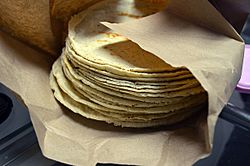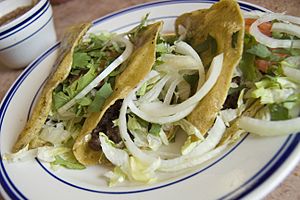Corn tortilla facts for kids
 |
|
| Type | Flatbread |
|---|---|
| Place of origin | Mexico, Guatemala, El Salvador, Honduras |
| Main ingredients | Maize flour |
A corn tortilla is a thin, flat bread. It is made from a special kind of corn called hominy. This bread is very popular in North America, especially in Mexico. It is called "tortilla" because it looks like a small, round cake.
In Mexico, tortillas can be made from different colors of corn. You can find white, yellow, and even blue (or black) corn tortillas. These different colors come from the natural colors of the corn kernels. White and yellow tortillas are the most common ones you will see.
Long ago, before Europeans came to America, people in South America made a similar bread called arepa. The Spanish explorers saw these flatbreads and called them "tortilla" because they looked like their own traditional round cakes. The Aztecs, who lived in Mexico, called their corn tortillas tlaxcalli. These Aztec tortillas are the ancestors of the corn tortillas we know today.
Contents
What Does "Tortilla" Mean?
The word tortilla comes from Spanish. It means "little cake." The Spanish word torta means "cake," and -illa means "little."
The Aztec word for tortilla, tlaxcalli, means "something baked." It comes from their verb (i)xca, which means "to bake."
It is important not to confuse a corn tortilla with a Spanish omelette. In Spain, "tortilla" can also mean an omelette made with eggs. But a corn tortilla is a type of bread, not an egg dish.
The History of Corn Tortillas
Corn tortillas first came from Mexico. They were a very important food for ancient cultures in North and Central America. People ate them long before wheat was brought to the Americas by Europeans. This means corn tortillas are much older than wheat flour tortillas.
In Aztec times, people ate corn tortillas with every meal. They might eat them plain or dip them in sauces made from chili peppers. Aztec markets also sold tortillas filled with foods like turkey meat, beans, honey, and squash.
Other similar foods made from hominy in Mexico include the sope, totopo, gordita, and tlacoyo. In Central America, there is the pupusa. These foods are all related to the corn tortilla.
Corn Tortillas in Mexico

Corn has been a main food in Mexico for hundreds of years. It is the most grown crop in the country. Mexico grows over 42 different types of corn. Each type has many varieties, possibly more than 3,000! The type of corn depends on the soil, how much water it gets, and how high up it grows.
Corn is the main ingredient in most Mexican dishes. The most common use for corn in Mexico is to make tortillas. But it is also used in other foods like tamales.
People in Mexico eat tortillas every day. You can buy them from factories or make them at home. Tortilla factories start making them early in the morning. This is because lunch is the biggest meal of the day for most people in Mexico. Lunch is usually eaten between 1:30 p.m. and 3:30 p.m.
Tortillas come in different flavors and colors, depending on the corn used. They are served with many traditional Mexican foods.
Here are some popular Mexican dishes made with corn tortillas:
- Chalupas
- Chilaquiles
- Enchiladas
- Gorditas
- Quesadillas
- Sopes
- Tacos
- Tortilla chips (called Totopos)
- Tortilla soup
- Tostadas
How Are Corn Tortillas Made?
Making a corn tortilla starts with a special process called nixtamalization. This is how it works:
- First, corn kernels are soaked in limewater. This makes the outer skin of the corn peel off.
- Next, the softened corn is ground into a dough. This dough is called masa nixtamalera.
- Then, the dough is pressed flat into thin, round shapes. This can be done with a rolling pin or a special tortilla press.
- Finally, the thin patties are cooked on a very hot comal. A comal is a flat cooking surface, like a griddle.
This nixtamalization process was discovered by ancient cultures in the Americas. It is very important because it helps your body get important vitamins like niacin (a B vitamin) from the corn. Without this step, people who ate a lot of corn could get sick with a disease called pellagra.
Today, in many Mexican cities, machines make corn tortillas. These tortillas are very thin and all look the same. But in many other places, people still make them by hand. Corn tortillas are best when served and eaten warm. When they get cool, they can become chewy or crumbly.
The largest company that makes tortillas in the world is Gruma, which is based in Mexico.
Long ago, and even in some places today, women would prepare the masa by hand. They used a special stone tool called a mano (like a rolling pin) and a stone base called a metate.
Wheat flour tortillas are different. They were invented after wheat came to the Americas from Spain. They are made with a simple dough of wheat flour and water. They are pressed and cooked like corn tortillas. These tortillas are similar to flatbreads found in other parts of the world, like India's roti.
Tortillas come in many sizes. They can be small, about 6 centimeters (2.4 inches) wide, or very large, over 30 centimeters (12 inches) wide. The size depends on where they are made and what dish they will be used for.
Some foods are like tortillas but are thicker. These include pupusas, gorditas, and sopes. They often have other ingredients mixed in, like beans.
In Nicaragua, there are thick, sweet tortillas called güirilas. They are made from young, white corn. In Argentina, Bolivia, and southern Chile, people eat smaller, saltier tortillas. These are often roasted in a traditional oven and are called sopaipilla.
A person who sells tortillas is called a tortillero in Spanish.
How Nutritious Are Corn Tortillas?
| Nutritional value per 100 g (3.5 oz) | |
|---|---|
| Energy | 912 kJ (218 kcal) |
|
44.6 g
|
|
| Sugars | 0.9 g |
| Dietary fiber | 6.3 g |
|
2.8 g
|
|
|
Protein
|
5.7 g
|
| Vitamins | Quantity
%DV†
|
| Thiamine (B1) |
8%
0.09 mg |
| Riboflavin (B2) |
5%
0.06 mg |
| Niacin (B3) |
9%
1.5 mg |
| Pantothenic acid (B5) |
2%
0.11 mg |
| Vitamin B6 |
17%
0.22 mg |
| Folate (B9) |
1%
5 μg |
| Choline |
3%
13.3 mg |
| Vitamin C |
0%
0 mg |
| Vitamin E |
2%
0.3 mg |
| Minerals | Quantity
%DV†
|
| Calcium |
8%
81 mg |
| Copper |
8%
0.15 mg |
| Iron |
9%
1.2 mg |
| Magnesium |
20%
72 mg |
| Manganese |
16%
0.33 mg |
| Phosphorus |
45%
314 mg |
| Potassium |
6%
186 mg |
| Sodium |
3%
45 mg |
| Zinc |
14%
1.3 mg |
| Other constituents | Quantity |
| Water | 45.9 g |
|
Link to USDA Database entry
|
|
| †Percentages estimated using US recommendations for adults. | |
Corn tortillas are a good source of energy. They contain carbohydrates, which give you energy. They also have some protein and fat.
A 100-gram serving of raw corn tortilla gives you about 218 calories. It is also a great source of phosphorus and magnesium. These minerals are important for strong bones and muscles. Corn tortillas also provide some vitamin B6, niacin, manganese, and zinc.
What Are Corn Tortillas Used For?
Corn tortillas are the main ingredient in many classic Mexican dishes. Here are some examples:
- Tacos: Tortillas folded around fillings.
- Tostadas: Crispy, flat tortillas with toppings.
- Enchiladas: Tortillas rolled around fillings and covered in sauce.
- Quesadillas: Tortillas filled with cheese and heated.
- Chilaquiles: Tortilla pieces cooked in salsa.
- Tortilla soup: A delicious soup with tortilla strips.
Warm corn tortillas are often served with stews, soups, or grilled meats. They are used like bread in other cultures.
Wheat flour tortillas are often used for burritos.
Corn tortillas can also be deep-fried to make crispy tortilla chips. These chips are often salted. You can eat them alone or with different salsas and dips like guacamole. Tortilla chips are also a key ingredient in nachos.
Images for kids
See also
 In Spanish: Tortilla de maíz para niños
In Spanish: Tortilla de maíz para niños






